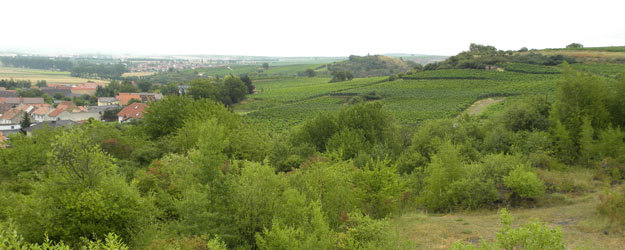OPPENHEIM, GERMANY–I want this termed Wilson’s Law: “The amount of mud encountered at an outcrop is inversely proportional to the quality of the fossils found.” Maybe it is my desert heritage, but I absolutely detest mud on my boots. Especially deep sticky quarry mud that grips lug soles and builds a progressively larger glob with every step. I try very hard to avoid slogs through it, but I’ve been spectacularly unable to avoid it in some places. Far too often I’ve slipped and slid through the glutinous stuff to find the rocks at the end to be distinctly unfossiliferous. Well mudded for little reward. Such was the case at the Rüssingen Limestone Quarry pictured below:
 Today was a wet one in the Mainz Basin, and my fossil bag remained relatively empty except for some mollusk shells with borings (many of which are well described on this amateur’s page). Still, the geology was very interesting. The Mainz Basin is not a true basin in the geological sense. It is better described as a fracture zone at the western border of the Upper Rhine Graben. We were most interested in the shallow marine and brackish water Oligocene sediments deposited within these boundaries. Some of the sediments rested directly on sea cliffs of Permian rhyolite which was spectacular (but alas, not photogenic).
Today was a wet one in the Mainz Basin, and my fossil bag remained relatively empty except for some mollusk shells with borings (many of which are well described on this amateur’s page). Still, the geology was very interesting. The Mainz Basin is not a true basin in the geological sense. It is better described as a fracture zone at the western border of the Upper Rhine Graben. We were most interested in the shallow marine and brackish water Oligocene sediments deposited within these boundaries. Some of the sediments rested directly on sea cliffs of Permian rhyolite which was spectacular (but alas, not photogenic).

Clasts in the Alzey Formation (Oligocene, Rupelian) exposed near Wöllstein, Germany. The large pebble by the two-Euro coin is a Permian rhyolite; the white pebbles are from quartz veins in metamorphic rock. Both clast types were derived from nearby rocky cliffs during deposition.
Our last stop of the day was the Naturhistorisches Museum Mainz (Mainz Natural History Museum). This was much fun, especially since we had a special dinner with the director and staff in the galleries. The collection and displays are very good. I could have the usual photo of some vertebrate fossil in a case, but instead I was taken with a humble drawer of fossil snails packed in cotton so that they appeared to be floating in clouds:




